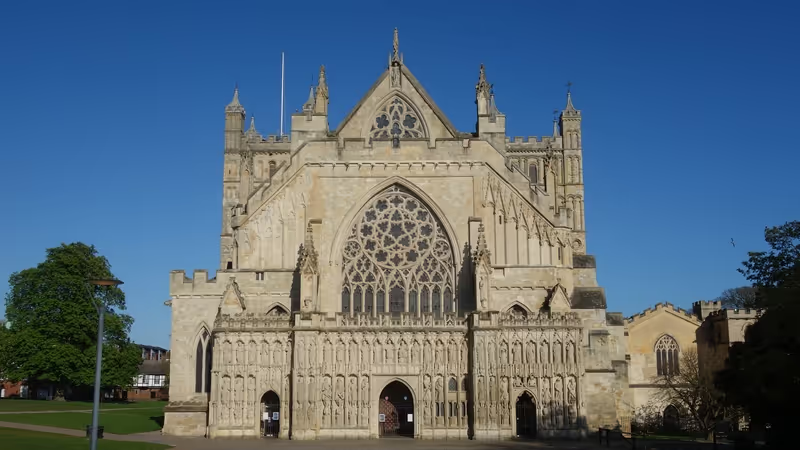Exeter Civic Society and the progressive group of Green, Liberal Democrat and Independent city councillors have raised the alarm at the prospect of development on green spaces beside the River Exe and a heritage harbour site in the city’s historic canal basin.
Exeter City Council is considering developing sites at Bonhay Meadows, the canal basin and in the heart of Riverside Valley Park as part of its “Liveable Exeter” property development scheme while claiming that the scheme “will protect and enhance Exeter’s exceptional natural and historic environment, safeguard its iconic landscape setting and encourage high-quality design that complements and enhances the city’s heritage.”
It first emerged that the council was considering these developments when council leader Phil Bialyk listed what he described as “a pipeline of future development opportunities for the council to consider as part of a five year development programme” in a committee meeting last year.
Diana Moore, Green Party councillor for St David’s ward, in which all three sites are located, then confirmed the council’s intent at a meeting in April.
She said: “In response to questions I asked at a council meeting, the Labour leader of the city council failed to provide assurance that valuable green spaces in the city – vital for wildlife and biodiversity – would be safe from future development.
“He confirmed that Bonhay Meadows is being considered as a development site and refused to rule out development on the green space between the river and Exeter Ship Canal.”
 Bonhay Meadows Liveable Exeter development site
Bonhay Meadows Liveable Exeter development site
Exeter Civic Society said it was “appalled to discover that Exeter City Council is considering building homes on the city’s green spaces” and is “likely to rigorously oppose building” on all three sites.
Keith Lewis, acting chair of the society, has written to Phil Bialyk to express his concern that the proposals were not highlighted in May’s local elections manifestos and that no consultation concerning them had taken place with local communities.
He said: “It seems that there has been no dialogue with local councillors, let alone with the communities in which [the development sites] are located.
“The society is concerned that the city council will present the public with a fait accompli rather than undertaking genuine community consultation in line with government guidelines.”
“This reinforces the council’s disregard for genuine public consultation.”
Addressing the council leader directly, he said: “I urge you to publish development proposals for all the sites identified in your paper last year to get public opinion before spending too much on research and architects fees”, adding: “What do you have to hide?”
 Bonhay Meadows Liveable Exeter development site entrance via flood defence scheme gate No.6
Bonhay Meadows Liveable Exeter development site entrance via flood defence scheme gate No.6
Bonhay Meadows, which is described as “accessible amenity green space” by the city council, has been identified as a prospective site for 97 dwellings which would be built by Exeter City Living Ltd, the city council’s property development company.
It is a 1.6 acre grass and wildflower meadow bordered by mature trees which lies on the east bank of the river, north of the Exe Bridges crossing.
It is located on the river side of the flood defence scheme wall which has been constructed to protect existing buildings nearby. Exeter City Living was described as “in dialogue” with the Environment Agency over this issue.
At the April meeting at which Phil Bialyk defended the council’s approach he said: “Exeter City Living, the development arm of the city council, is examining, and will continue to examine, the suitability of land for development in accordance with the vision for Liveable Exeter - including sites such as Bonhay Meadows.”
He added: “We are not ruling anything out, nor should we.”
 Exeter Ship Canal basin Liveable Exeter development site location plan.
Exeter Ship Canal basin Liveable Exeter development site location plan.
Image: Canal Basin masterplan.
The site identified for development at the canal basin currently houses Exe Water Sports Association and the Ride On bicycle recycling project. Around 50 build-to-rent dwellings would take their place, also constructed by Exeter City Living Ltd.
These proposals are consistent with the Canal Basin masterplan, which says: “The existing buildings do not make sufficient contribution to the character of the conservation area to warrant retention. The quality of the townscape may be improved by sensitive re-development.”
It adds: “Contemporary architecture that is clearly respectful of its context is required” and identifies historic elements for retention in any redevelopment, including the wall which runs along Haven Road, which originally enclosed the basin, and a locally listed gateway and piers which must be retained and incorporated into any design for the site.
It specifies that “two storey residential scale buildings are required” on the site beside 60 Haven Road, which is a Grade II listed building which previously part-housed Exeter Maritime Museum and, more recently, the Boatyard Bakery. It also says that “three to three and a half storey residential scale buildings are required” on the rest of the site.
It is not clear how the council intends to fit 50 dwellings onto the site given these planning policy restrictions.
 Exeter Ship Canal Liveable Exeter development site illustrative elevations.
Exeter Ship Canal Liveable Exeter development site illustrative elevations.
Image: Canal Basin masterplan.
There have been calls for the canal basin masterplan to be updated, both because of its age - it was adopted as planning policy seventeen years ago, in July 2004 - and because it does not specify that the uses of buildings in the area must be waterway-related.
Six years ago Exeter Civic Society set up a River, Canal and Quayside sub-committee which subsequently published a report focussed on the future of the quay and the canal basin area.
It said: “One of its qualities is that it is relaxed and not crassly and commercially over-exploited. We want to see this quality preserved while its distinctive heritage, tourist, arts and educational potential is sensitively developed.”
 Exeter Ship Canal Liveable Exeter development site
Exeter Ship Canal Liveable Exeter development site
Then in 2016 the Friends of Exeter Ship Canal was established with support from the civic society and went on to develop a close relationship with the Inland Waterways Association.
This led to last year’s heritage harbour status award to the Port of Exeter, the first such award in the south west.
The Friends of Exeter Ship Canal also published a report in which it outlined considerations which were necessary if the canal – and particularly the canal basin – was to become more than an environment shaped by the demands of investment finance.
It called for better promotion of the canal, new slipways, residential moorings, canal holidays and development of heritage and maritime activities in the canal basin. It did not call for new housing development.
 Exeter Ship Canal Liveable Exeter development site listed wall, gateway and piers at Exe Water Sports Association
Exeter Ship Canal Liveable Exeter development site listed wall, gateway and piers at Exe Water Sports Association
Following the heritage harbour award, the Inland Waterways Association and Friends of Exeter Ship Canal also jointly published a new vision and action plan for the canal.
John Monks of Friends of the Exeter Ship Canal said: “The city council and [quay and canal] trust are both enthusiastic about the Heritage Harbour designation the Friends achieved for the canal and basin as integral parts of the Port of Exeter.
“To get the most from it depends on their seeing it not so much as a status flag but as a stimulus to work together on creating the maritime heritage revival that is at the heart of every heritage harbour.”
Unsurprisingly, the action plan also does not propose housing development in the canal basin.
Keith Lewis of Exeter Civic Society said: “The heritage harbour status obtained by the Friends of Exeter Ship Canal should now require the council to think again about what should be done around the basin and canal if that initiative is to be a success.
“The existing basin masterplan has not been fit for purpose for some time now and should not be used to justify building a large number of homes there.”
 New Haven Field in Exeter’s Riverside Valley Park
New Haven Field in Exeter’s Riverside Valley Park
The third site threatened by the Liveable Exeter property development scheme is in Exeter’s Riverside Valley Park between the ship canal and the river, a short walk from the canal basin.
It is a 2.4 acre grass meadow known as New Haven Field which is bordered by mature hedgerows and trees and tucked between Trews Weir allotments and Bromhams Playing Fields.
It is described as “accessible natural green space” by the city council.
Details about development plans for this site remain unclear, but it appears to be mentioned in a county council transport infrastructure implementation report which describes a “new crossing of the canal in Haven Banks linked to development”.
New Haven Field is only a short distance from the railway station being built beside the Marsh Barton waste incinerator.
Diana Moore said: “Important and much loved green and wooded spaces run along the river and canal - that’s precisely why they are recognised in the Exeter valley parks strategy.
“These spaces need protection and nurturing. The opportunities lie in planting trees and helping nature - not putting a development price tag on them.”
 New Haven Field in Exeter’s Riverside Valley Park
New Haven Field in Exeter’s Riverside Valley Park
Having previously planned to sell part of Bull Meadow Park and all of Northbrook Approach golf course for housing development, the city council changed course after community campaigns to save both green spaces.
Phil Bialyk subsequently said, in the run up to this year’s local elections: “Where we can we will protect open and green spaces. We have still got to deliver housing - that’s where our Liveable Exeter programme comes in and it is very important.
“But I want us to save green spaces and keep them for our children and grandchildren to enjoy. We have done all lot already - protecting Bull Meadow and Northbrook.”
Independent councillor Jemima Moore recently highlighted that a community campaign had, in fact, helped save the Northbrook site.
She said: “As so often in Exeter, it was a community campaign that helped secure the Northbrook for nature and wildlife. We need to see the Labour-led council do more to identify and protect in perpetuity the city’s crucial green spaces.”
Liberal Democrat councillor Kevin Mitchell added: “The almost universal support for a wildlife-focussed future for the Northbrook site demonstrates how Exeter residents value green spaces and trees, and see these as vital for wildlife, recreation and health.
“They also need to be aware, however, that the city’s green spaces aren’t guaranteed protection under Labour.”










